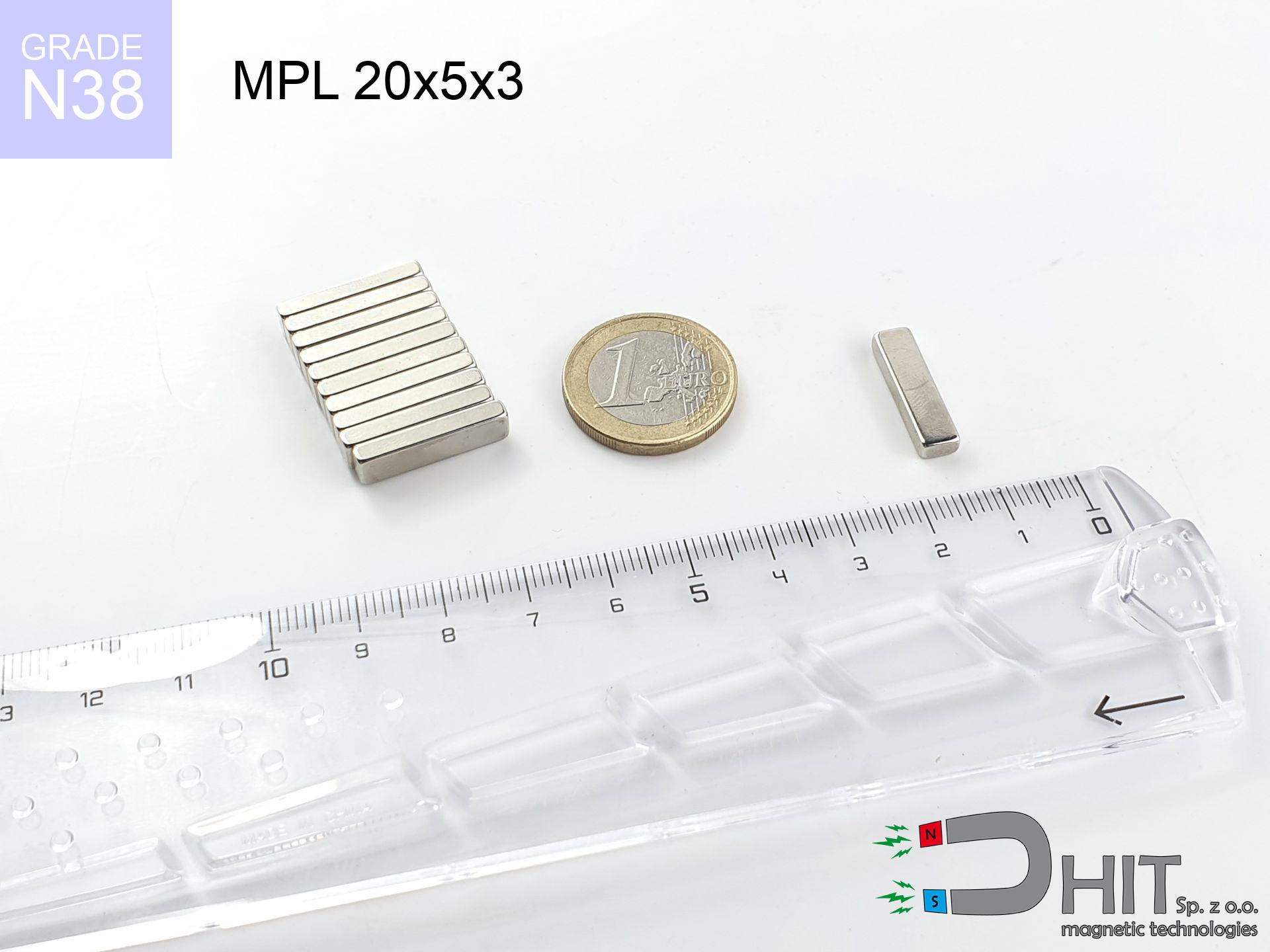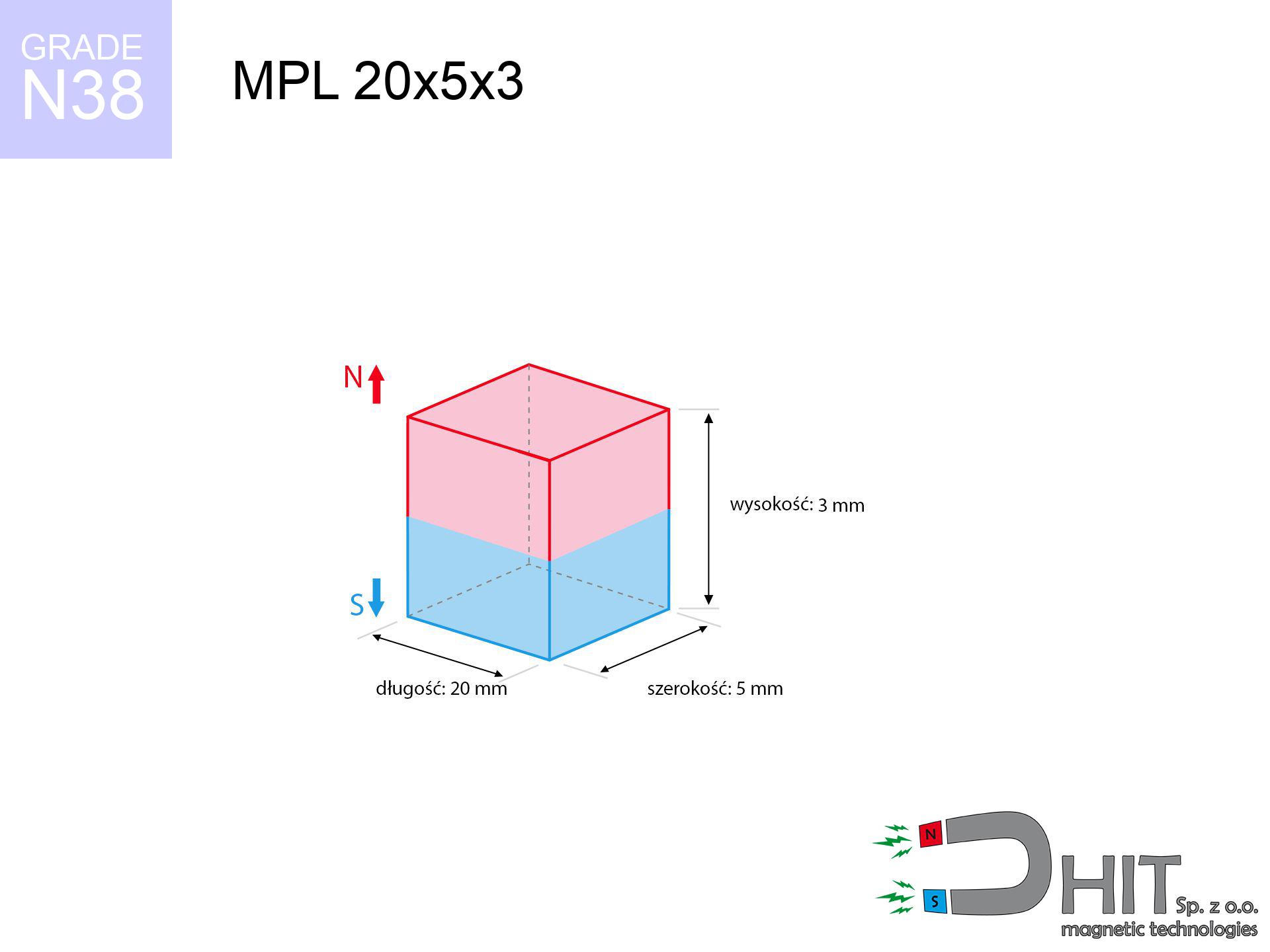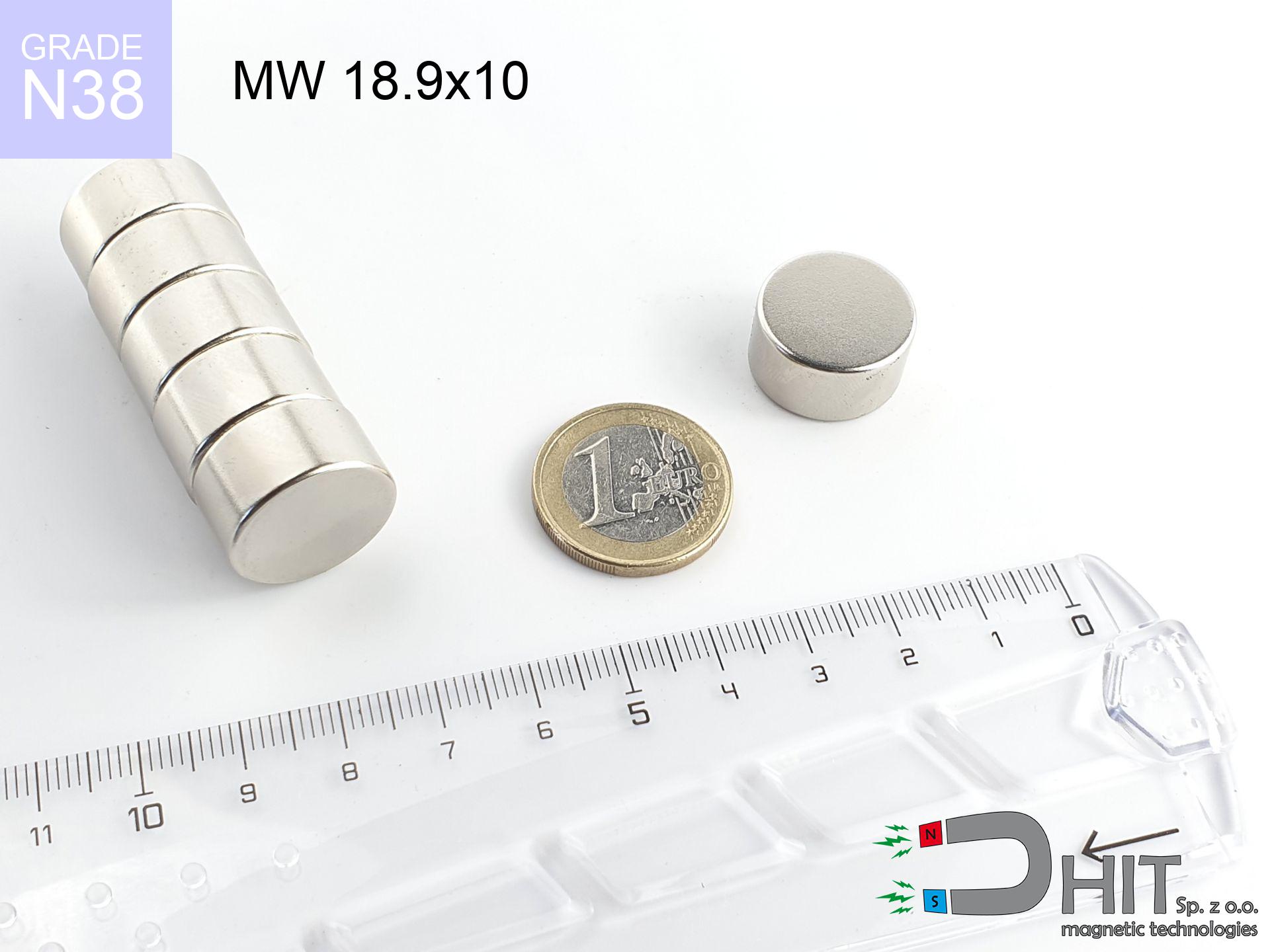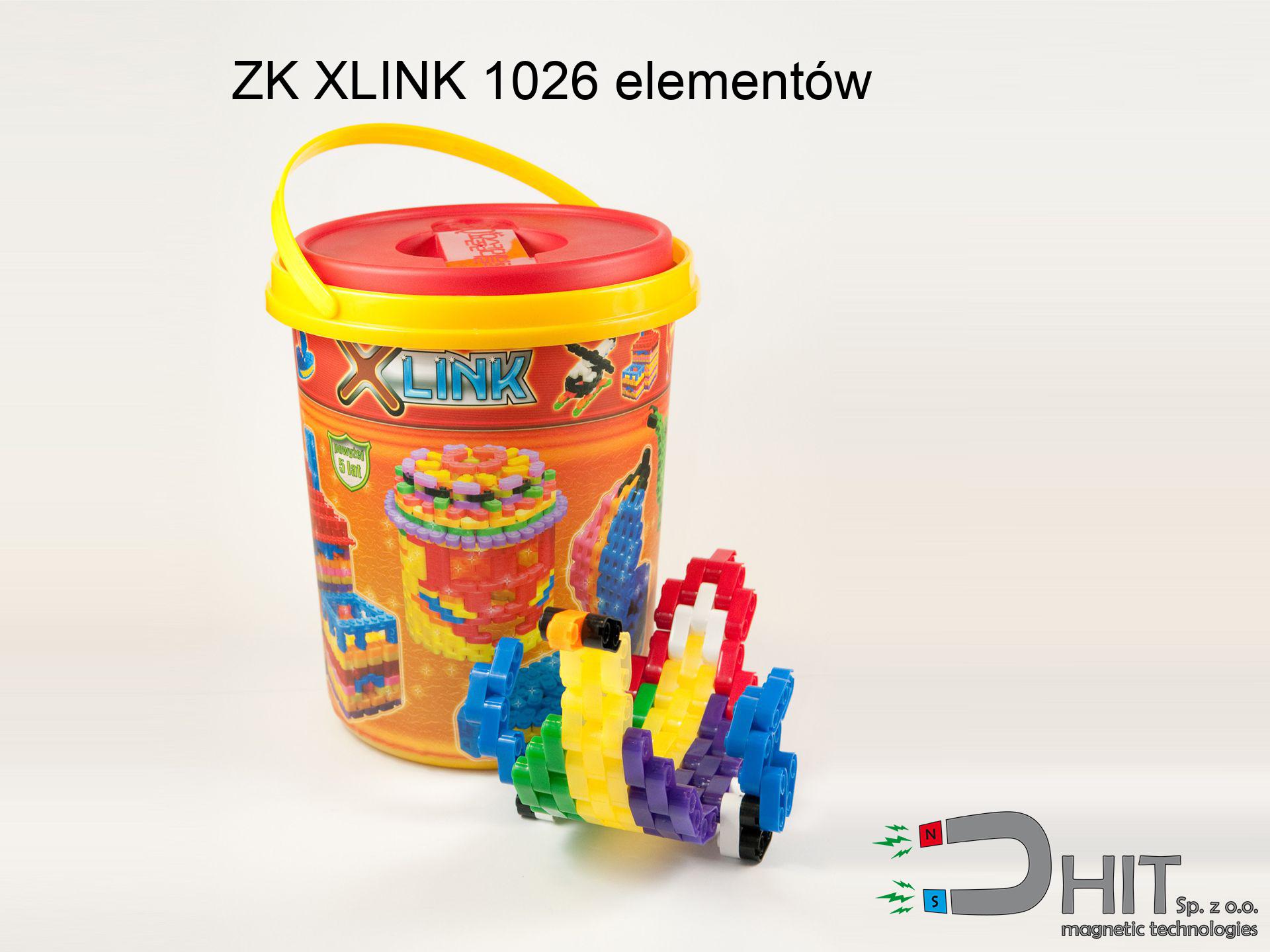MPL 20x5x3 / N38 - lamellar magnet
lamellar magnet
Catalog no 020131
GTIN: 5906301811374
length [±0,1 mm]
20 mm
Width [±0,1 mm]
5 mm
Height [±0,1 mm]
3 mm
Weight
2.25 g
Magnetization Direction
↑ axial
Load capacity
2.37 kg / 23.24 N
Magnetic Induction
358.88 mT
Coating
[NiCuNi] nickel
1.058 ZŁ with VAT / pcs + price for transport
0.860 ZŁ net + 23% VAT / pcs
bulk discounts:
Need more?Not sure about your choice?
Pick up the phone and ask
+48 22 499 98 98
otherwise drop us a message via
contact form
our website.
Strength along with appearance of magnetic components can be reviewed with our
magnetic mass calculator.
Same-day shipping for orders placed before 14:00.
Magnetic properties of material N38
Physical properties of sintered neodymium magnets Nd2Fe14B at 20°C
Shopping tips
Strengths and weaknesses of rare earth magnets.
In addition to their magnetic efficiency, neodymium magnets provide the following advantages:
- They have constant strength, and over more than ten years their performance decreases symbolically – ~1% (according to theory),
- Neodymium magnets prove to be remarkably resistant to demagnetization caused by external interference,
- By using a decorative layer of gold, the element has an modern look,
- They are known for high magnetic induction at the operating surface, making them more effective,
- Made from properly selected components, these magnets show impressive resistance to high heat, enabling them to function (depending on their form) at temperatures up to 230°C and above...
- Thanks to modularity in shaping and the capacity to customize to complex applications,
- Wide application in electronics industry – they are utilized in hard drives, electric drive systems, diagnostic systems, also other advanced devices.
- Relatively small size with high pulling force – neodymium magnets offer strong magnetic field in tiny dimensions, which makes them useful in miniature devices
Disadvantages of NdFeB magnets:
- At very strong impacts they can break, therefore we advise placing them in steel cases. A metal housing provides additional protection against damage and increases the magnet's durability.
- When exposed to high temperature, neodymium magnets suffer a drop in power. Often, when the temperature exceeds 80°C, their strength decreases (depending on the size and shape of the magnet). For those who need magnets for extreme conditions, we offer [AH] versions withstanding up to 230°C
- When exposed to humidity, magnets start to rust. To use them in conditions outside, it is recommended to use protective magnets, such as magnets in rubber or plastics, which prevent oxidation as well as corrosion.
- Limited ability of creating threads in the magnet and complex forms - recommended is a housing - mounting mechanism.
- Possible danger resulting from small fragments of magnets pose a threat, if swallowed, which becomes key in the context of child safety. Additionally, small elements of these magnets are able to disrupt the diagnostic process medical after entering the body.
- High unit price – neodymium magnets have a higher price than other types of magnets (e.g. ferrite), which increases costs of application in large quantities
Highest magnetic holding force – what contributes to it?
The lifting capacity listed is a result of laboratory testing conducted under specific, ideal conditions:
- with the application of a yoke made of special test steel, guaranteeing maximum field concentration
- whose transverse dimension reaches at least 10 mm
- with an ideally smooth contact surface
- without the slightest insulating layer between the magnet and steel
- during detachment in a direction perpendicular to the plane
- at ambient temperature room level
What influences lifting capacity in practice
During everyday use, the real power is determined by several key aspects, ranked from most significant:
- Distance (between the magnet and the metal), as even a tiny distance (e.g. 0.5 mm) leads to a reduction in lifting capacity by up to 50% (this also applies to varnish, rust or dirt).
- Force direction – catalog parameter refers to pulling vertically. When slipping, the magnet exhibits significantly lower power (often approx. 20-30% of nominal force).
- Element thickness – for full efficiency, the steel must be adequately massive. Thin sheet restricts the lifting capacity (the magnet "punches through" it).
- Plate material – mild steel attracts best. Higher carbon content reduce magnetic permeability and lifting capacity.
- Smoothness – full contact is possible only on smooth steel. Any scratches and bumps create air cushions, reducing force.
- Thermal factor – high temperature reduces pulling force. Exceeding the limit temperature can permanently damage the magnet.
* Lifting capacity testing was carried out on a smooth plate of optimal thickness, under perpendicular forces, whereas under attempts to slide the magnet the holding force is lower. Additionally, even a minimal clearance {between} the magnet and the plate reduces the lifting capacity.
Warnings
Pacemakers
Medical warning: Neodymium magnets can deactivate heart devices and defibrillators. Stay away if you have electronic implants.
Respect the power
Exercise caution. Neodymium magnets attract from a distance and snap with massive power, often faster than you can move away.
Keep away from computers
Very strong magnetic fields can corrupt files on credit cards, hard drives, and other magnetic media. Keep a distance of min. 10 cm.
Maximum temperature
Control the heat. Heating the magnet to high heat will permanently weaken its properties and strength.
Fragile material
Watch out for shards. Magnets can explode upon uncontrolled impact, ejecting sharp fragments into the air. Eye protection is mandatory.
Combustion hazard
Drilling and cutting of NdFeB material poses a fire risk. Neodymium dust reacts violently with oxygen and is hard to extinguish.
Metal Allergy
Allergy Notice: The nickel-copper-nickel coating consists of nickel. If redness appears, immediately stop handling magnets and use protective gear.
Bodily injuries
Pinching hazard: The pulling power is so great that it can result in blood blisters, crushing, and even bone fractures. Protective gloves are recommended.
Do not give to children
Neodymium magnets are not suitable for play. Accidental ingestion of multiple magnets can lead to them connecting inside the digestive tract, which poses a critical condition and necessitates urgent medical intervention.
Impact on smartphones
Note: neodymium magnets generate a field that disrupts precision electronics. Keep a safe distance from your mobile, device, and navigation systems.
Warning!
More info about hazards in the article: Magnet Safety Guide.






![UMP 67x28 [M8+M10] GW F120 Lina / N38 - search holder UMP 67x28 [M8+M10] GW F120 Lina / N38 - search holder](https://cdn3.dhit.pl/graphics/products/ump-67x28-m8+m10-gw-f-120+-lina-xiw.jpg)


